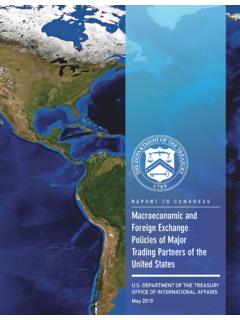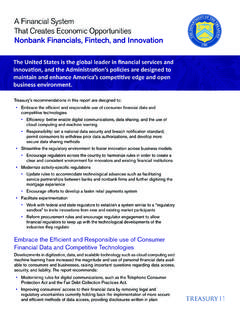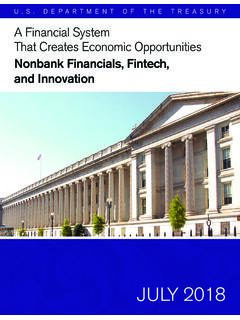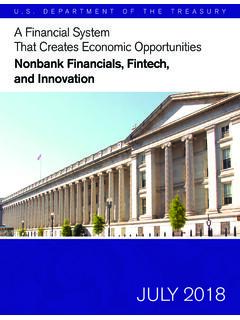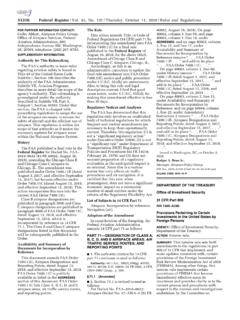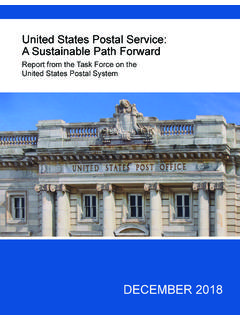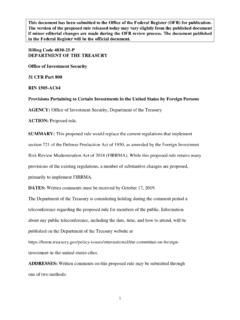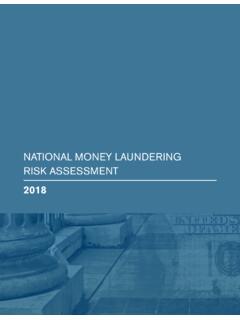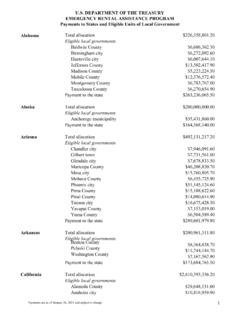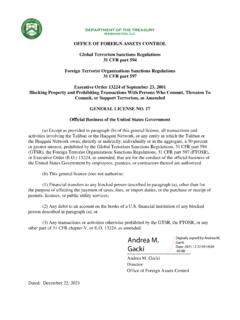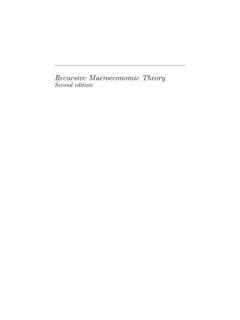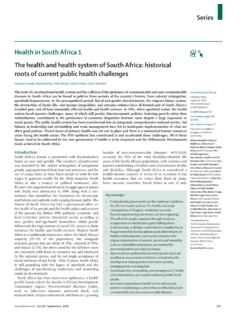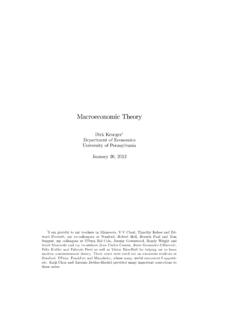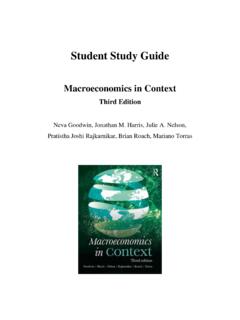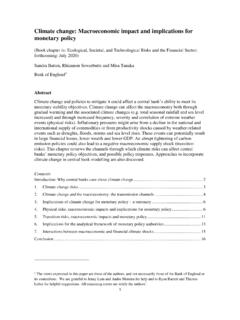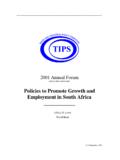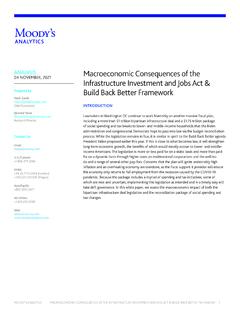Transcription of REPORT TO CONGRESS Macroeconomic and
1 R EP O RT TO CO NG R E SS. Macroeconomic and Foreign Exchange policies of Major Trading Partners of the United States DEPARTMENT OF THE TREASURY. OFFICE OF INTERNATIONAL AFFAIRS. April 2021. Contents EXECUTIVE SUMMARY .. 1. SECTION 1: GLOBAL ECONOMIC AND EXTERNAL DEVELOPMENTS .. 6. ECONOMIC TRENDS .. 6. ECONOMIC DEVELOPMENTS IN SELECTED MAJOR TRADING PARTNERS .. 15. ENHANCED ANALYSIS UNDER THE 2015 ACT .. 40. SECTION 2: INTENSIFIED EVALUATION OF MAJOR TRADING PARTNERS ..54. KEY CRITERIA .. 54. SUMMARY OF 58. GLOSSARY OF KEY TERMS IN THE REPORT ..60. This REPORT reviews developments in international economic and exchange rate policies and is submitted pursuant to the Omnibus Trade and Competitiveness Act of 1988, 22. 5305, and Section 701 of the Trade Facilitation and Trade Enforcement Act of 2015, 19 1 The Treasury Department has consulted with the Board of Governors of the Federal Reserve System and International Monetary Fund management and staff in preparing this REPORT .
2 Executive Summary The global economy experienced a tumultuous year in 2020 as a result of the SARS-Cov-2. (COVID-19) pandemic. The unprecedented nature of the crisis as well as the difficulty in separating temporary versus structural changes makes analysis of current accounts and exchange rates an even more difficult task than usual. The impact of the virus led to a deep global contraction in the first half of 2020. Governments implemented public health policies and restrictions on mobility to arrest the spread of the virus, and households and businesses became more cautious in spending and investment decisions. Governments also provided historic economic support to offset the damaging effects of the virus through direct fiscal spending as well as indirect measures. In addition, central banks took prompt actions to support economic conditions through expansions and extensions of monetary easing as well as policies aimed at stabilizing financial markets.
3 Global trade also contracted in the first half of 2020 resulting from ruptures in supply chains and declining demand. Services were particularly hard hit as travel and tourism collapsed. For many emerging market and developing economies the global shock resulted in large capital outflows and sharp downward pressures on their currencies. Global economic conditions improved in the second half of the year as policy measures provided support for individuals and businesses. Stabilizing financial conditions and the recovering global economy led to a reversal in exchange rates and capital flows from early in the year. Goods trade and commodity prices picked up but tourism and travel continued to remain depressed. Strong domestic policy support buoyed demand in some countries while in countries where support was limited domestic demand remained weak. The COVID crisis is likely to continue to affect current account positions over the next year as recoveries accelerate in some countries and lag in others.
4 The longer-term effects of the crisis on global trade and incomes will become clearer over time as structural changes emerge. The International Monetary Fund (IMF) estimates the global economy contracted in 2020, the worst recession since the Great Depression. The IMF expects global growth to return in 2021, but recovery will be unequal among economies and depend upon the evolution of the pandemic, vaccine access, the degree to which policy support can limit longer-term economic scarring, as well as developments in financial conditions and commodity prices. Against this backdrop, it is critical that fiscal and monetary policies in the major economies remain supportive. International economic cooperation and support for the most vulnerable countries will remain necessary to support a robust recovery and prevent a divergence in growth paths between advanced economies and emerging market and developing economies. Over the four quarters through December 2020, a number of economies have experienced significant expansions in their current account surpluses as the pandemic drastically affected global trade, including China, Taiwan, and Singapore, while other economies, including Germany and Vietnam, have maintained large current account surpluses, which 1.
5 Allowed for external asset stock positions to widen further. The total goods trade deficit widened to of GDP in the fourth quarter of 2020 from of GDP at the end of 2019. The current account deficit expanded to of GDP in the fourth quarter, percentage points larger than at the end of 2019 and the largest deficit as a share of GDP since the final quarter of 2008. Treasury remains concerned by how persistent current account imbalances will evolve as the effects of the pandemic subside. With heightened risks of economic scarring, it is important that governments bolster domestic- led rather than externally supported growth . Treasury is also concerned by certain economies raising the scale and persistence of foreign exchange intervention to resist appreciation of their currencies in line with economic fundamentals. Treasury continues to press other economies to uphold the exchange rate commitments they have made in the G-20, the G-7, and at the IMF.
6 All G-20. members have agreed that strong fundamentals and sound policies are essential to the stability of the international monetary system. Additionally, all members remain committed that their exchange rates reflect underlying economic fundamentals and note that exchange rate flexibility can facilitate the adjustment of their economies. G-20 members have also committed to: consult closely on foreign exchange market developments, refrain from competitive devaluations, and not target exchange rates for competitive purposes. G-7 economies, meanwhile, remain committed to: market-determined exchange rates, using domestic tools to meet domestic objectives, and consulting closely and cooperating as appropriate with regards to action in foreign exchange markets. IMF members have committed to avoid manipulating their exchange rates to gain an unfair competitive advantage over other members. Nevertheless, a number of economies have conducted foreign exchange market intervention in a persistent, one-sided manner.
7 Over the four quarters through December 2020, five major trading partners Vietnam, Switzerland, Taiwan, India, and Singapore intervened in the foreign exchange market in a sustained, asymmetric manner with the effect of weakening their currencies. Three of these economies Vietnam, Switzerland, and Taiwan exceeded the two other thresholds established by Treasury to identify potentially unfair currency practices or excessive external imbalances, which could impede growth or harm workers and firms. Treasury Analysis Under the 1988 and 2015 Legislation The analysis in this REPORT is guided by Section 3001-3006 of the Omnibus Trade and Competitiveness Act of 1988 (1988 Act) and Sections 701 and 702 of the Trade Facilitation and Trade Enforcement Act of 2015 (2015 Act) as discussed in Section 2. 2. In this REPORT , Treasury has reviewed 20 major trading partners with bilateral goods trade with the United States of at least $40 billion annually against the thresholds Treasury has established for the three criteria in the 2015 Act: (1) Persistent, one-sided intervention in the foreign exchange market occurs when net purchases of foreign currency are conducted repeatedly, in at least 6 out of 12 months, and these net purchases total at least 2% of an economy's gross domestic product (GDP) over a 12-month (2) A material current account surplus is one that is at least 2% of GDP over a 12-month period.
8 (3) A significant bilateral trade surplus with the United States is one that is at least $20. billion over a 12-month In accordance with the 1988 Act, Treasury has also evaluated in this REPORT whether trading partners have manipulated the rate of exchange between their currency and the United States dollar for purposes of preventing effective balance of payments adjustments or gaining unfair competitive advantage in international trade. Because the standards and criteria in the 1988 Act and the 2015 Act are distinct, a trading partner could be found to meet the standards identified in one of the statutes without necessarily being found to meet the standards identified in the other. Section 2 provides further discussion of the distinctions between the 1988 Act and the 2015 Act. Treasury Conclusions Related to the 2015 Act Vietnam again exceeded the thresholds for all three criteria under the 2015 Act over the four quarters through December 2020.
9 Treasury has updated its enhanced analysis of Vietnam in this REPORT . In early 2021, Treasury commenced enhanced bilateral engagement with Vietnam and is working with the Vietnamese authorities to develop a plan with specific actions to address the underlying causes of Vietnam's currency undervaluation. Switzerland again exceeded the thresholds for all three criteria under the 2015 Act over the four quarters through December 2020. Treasury has updated its enhanced analysis of Switzerland in this REPORT . In early 2021, Treasury commenced enhanced bilateral 2 The REPORT covers data from the 12-month period ending in December 2020. These quantitative thresholds for the scale and persistence of intervention are considered sufficient on their own to meet this criterion. Other patterns of intervention, with lesser amounts or less frequent interventions, might also meet this criterion depending on the circumstances of the intervention.
10 3 Treasury focuses in this REPORT on trade in goods only, as it has done in past Reports. The United States has a surplus in services trade with many economies in this REPORT , including China, Japan, Korea, Singapore, and Switzerland, and to a lesser extent, Taiwan and Vietnam. Taking into account services trade would reduce the bilateral trade surplus of these economies with the United States. 3. engagement with Switzerland and is discussing with the Swiss authorities options to address the underlying causes of Switzerland's external imbalances. Taiwan exceeded the thresholds for all three criteria under the 2015 Act over the four quarters through December 2020. Treasury has conducted enhanced analysis of Taiwan in this REPORT and will also commence enhanced bilateral engagement with Taiwan in accordance with the 2015 Act. The bilateral engagement will include urging the development of a plan with specific actions to address the underlying causes of Taiwan's currency undervaluation.
